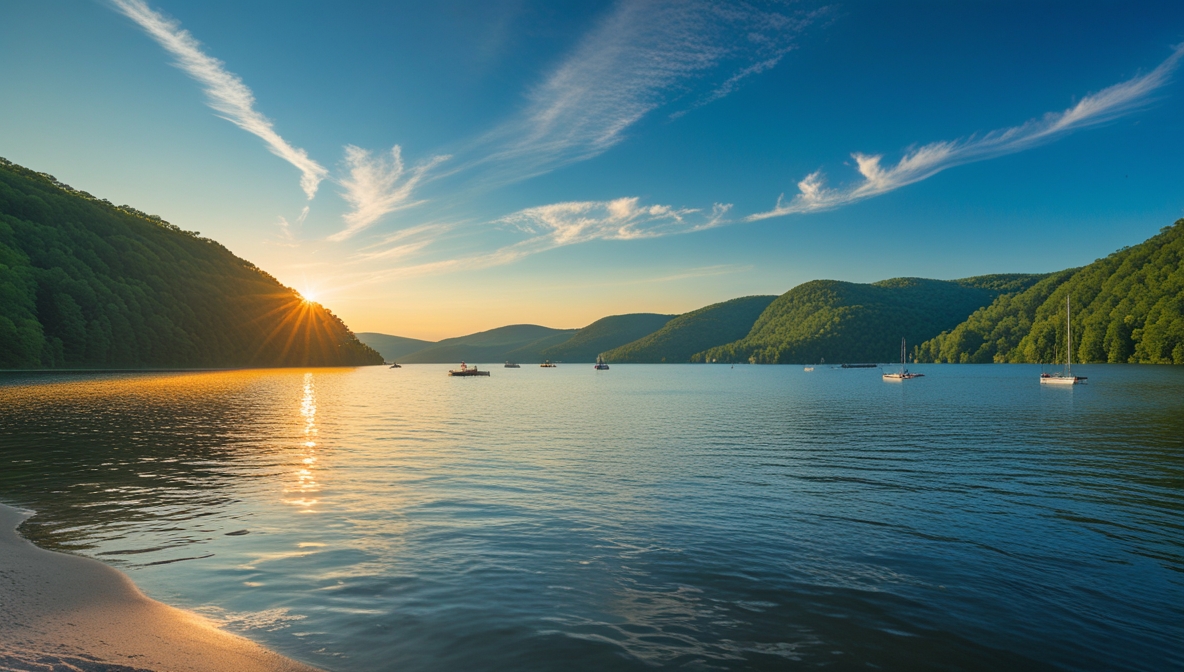Kentucky Lake, a prominent reservoir in the southeastern United States, spans multiple counties across Kentucky and Tennessee. Its vast expanse and intricate network of waterways make it a key landmark with immense natural, ecological, and recreational significance.
Overview of Kentucky Lake
Kentucky Lake is a product of the Tennessee Valley Authority (TVA) and was created by damming the Tennessee River at Kentucky Dam in the early 1940s. It serves as both a hydroelectric power source and a flood control system while offering abundant opportunities for fishing, boating, and other water activities.
- Length: Approximately 184 miles
- Surface Area: Roughly 160,300 acres
- Shoreline: Nearly 2,064 miles
- Location: Stretches from Gilbertsville, Kentucky, to Pickwick Landing Dam in Tennessee
Key Geographical Features
- The Tennessee River System
Kentucky Lake is formed by the Tennessee River, which runs its entire length. The river’s steady flow shapes the reservoir, contributing to its primary role in water management and navigation. This river system also feeds the lake with diverse aquatic habitats. - Land Between the Lakes National Recreation Area (LBL)
Located between Kentucky Lake and Lake Barkley, this 170,000-acre area offers a natural corridor filled with forests, wetlands, and open spaces. The LBL region serves as a crucial wildlife refuge and attracts outdoor enthusiasts. - Major Tributaries
Several rivers and streams flow into Kentucky Lake, enhancing its ecosystem:- Clarks River: Originates in Kentucky and flows into the lake’s northern section.
- Blood River: A critical tributary near Murray, Kentucky, known for its fishing hotspots.
- Big Sandy River: Enters the southern part of the lake in Tennessee, contributing to its expansive fishing waters.
- Islands and Inlets
The lake is dotted with numerous islands and inlets, creating secluded areas ideal for wildlife and anglers. Prominent examples include Jonathan Creek and Cypress Creek, which are famous for their rich biodiversity.
Surrounding Counties and Communities
- Kentucky
- Marshall County: Home to Kentucky Dam Village State Resort Park, this area is the gateway to the lake.
- Calloway County: Known for its proximity to Murray State University and the Blood River tributary.
- Livingston County: Offers access to the northern parts of the lake and features numerous marinas.
- Tennessee
- Henry County: Hosts the southern section of the lake, with Paris Landing State Park serving as a major recreational hub.
- Stewart County: Offers scenic views and quiet retreats, especially near Cross Creeks National Wildlife Refuge.
Ecological Significance
Kentucky Lake is a haven for wildlife and aquatic species. The reservoir supports diverse ecosystems, including:
- Fish Species: Largemouth bass, crappie, catfish, and sauger thrive here, making it one of the premier fishing destinations in the country.
- Birdlife: Migratory birds, such as bald eagles and herons, find refuge along the lake’s shores.
- Wetlands: These areas act as natural water filters and provide critical habitats for amphibians, insects, and reptiles.
Geological and Hydrological Aspects
The lake’s geology consists of sedimentary rock layers formed over millions of years, primarily limestone and sandstone. The Tennessee River’s damming altered the region’s hydrology, transforming floodplains into a reservoir. Seasonal variations in water levels are carefully managed by the TVA, with winter drawdowns and summer elevations.
The region around Kentucky Lake lies within the New Madrid Seismic Zone, known for occasional seismic activity. To stay informed about the latest tremors in the area, check the earthquake now site for real-time updates.
Recreational and Navigational Features
- Fishing
Anglers flock to Kentucky Lake for its variety of fish species. Areas such as Big Bear Bay and Jonathan Creek are renowned for their excellent catches. Refer to the year-round fishing calendar to plan your trip during peak seasons for specific fish species. - Boating
The vast expanse of the lake accommodates everything from kayaks to houseboats. Numerous marinas and boat ramps, including Moors Resort and Paris Landing Marina, support boating activities. - Hiking and Camping
Surrounding trails and campgrounds offer opportunities for hiking, birdwatching, and overnight stays, particularly within LBL.
Economic and Cultural Impact
Kentucky Lake significantly influences local economies through tourism and outdoor recreation. It also holds cultural importance, hosting annual events such as fishing tournaments and boat races. Nearby communities have embraced the lake as a vital part of their identity, integrating its natural beauty into their way of life.
Conclusion
The geography of Kentucky Lake is defined by its vast size, intricate ecosystems, and surrounding natural and human elements. From its roots in the Tennessee River to its role as a recreational and ecological hub, the lake represents a dynamic landscape that continues to shape the region it inhabits.
